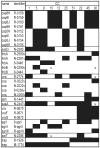Microarrays reveal that each of the ten dominant lineages of Staphylococcus aureus has a unique combination of surface-associated and regulatory genes
- PMID: 16385056
- PMCID: PMC1347281
- DOI: 10.1128/JB.188.2.669-676.2006
Microarrays reveal that each of the ten dominant lineages of Staphylococcus aureus has a unique combination of surface-associated and regulatory genes
Abstract
Staphylococcus aureus is the most common cause of hospital-acquired infection. In healthy hosts outside of the health care setting, S. aureus is a frequent colonizer of the human nose but rarely causes severe invasive infection such as bacteremia, endocarditis, or osteomyelitis. To identify genes associated with community-acquired invasive isolates, regions of genomic variability, and the S. aureus population structure, we compared 61 community-acquired invasive isolates of S. aureus and 100 nasal carriage isolates from healthy donors using a microarray spotted with PCR products representing every gene from the seven S. aureus sequencing projects. The core genes common to all strains were identified, and 10 dominant lineages of S. aureus were clearly discriminated. Each lineage carried a unique combination of hundreds of "core variable" (CV) genes scattered throughout the chromosome, suggesting a common ancestor but early evolutionary divergence. Many CV genes are regulators of virulence genes or known or predicted to be expressed on the bacterial surface and to interact with the host during nasal colonization and infection. Within each lineage, isolates showed substantial variation in the carriage of mobile genetic elements and their associated virulence and resistance genes, indicating frequent horizontal transfer. However, we were unable to identify any association between lineage or gene and invasive isolates. We suggest that the S. aureus gene combinations necessary for invasive disease may also be necessary for nasal colonization and that community-acquired invasive disease is strongly dependent on host factors.
Figures



References
-
- Baba, T., F. Takeuchi, M. Kuroda, H. Yuzawa, K. Aoki, A. Oguchi, Y. Nagai, N. Iwama, K. Asano, T. Naimi, H. Kuroda, L. Cui, K. Yamamoto, and K. Hiramatsu. 2002. Genome and virulence determinants of high virulence community-acquired MRSA. Lancet 359:1819-1827. - PubMed
-
- Cespedes, C., B. Said-Salim, M. Miller, S. H. Lo, B. N. Kreiswirth, R. J. Gordon, P. Vavagiakis, R. S. Klein, and F. D. Lowy. 2005. The clonality of Staphylococcus aureus nasal carriage. J. Infect. Dis. 191:444-452. - PubMed
-
- Day, N. P., C. E. Moore, M. C. Enright, A. R. Berendt, J. M. Smith, M. F. Murphy, S. J. Peacock, B. G. Spratt, and E. J. Feil. 2001. A link between virulence and ecological abundance in natural populations of Staphylococcus aureus. Science 292:114-116. - PubMed
Publication types
MeSH terms
Substances
Grants and funding
LinkOut - more resources
Full Text Sources
Other Literature Sources

